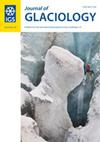Global clustering of recent glacier surges from radar backscatter data, 2017–2022
IF 2.6
3区 地球科学
Q2 GEOGRAPHY, PHYSICAL
引用次数: 1
Abstract
Using global Sentinel-1 radar backscatter data, we systematically map the locations of glaciers with surge-type activity during 2017–22. Patterns of pronounced increases or decreases in the strongest backscatter between two winter seasons often indicate large changes in glacier crevassing, which we treat here as a sign of surge-type activity. Validations against velocity time series, terminus advances and crevassing found in optical satellite images confirm the robustness of this approach. We find 115 surge-type events globally between 2017 and 2022, around 100 of which on glaciers already know as surge-type. Our data reveal a pronounced spatial clustering in three regions, (i) Karakoram, Pamirs and Western Kunlun Shan (~50 surges), (ii) Svalbard (~25) and (iii) Yukon/Alaska (~9), with only a few other scattered surges elsewhere. This spatial clustering is significantly more pronounced than the overall global clustering of known surge-type glaciers. The 2017–22 clustering may point to climatic forcing of surge initiation.2017-2022年雷达后向散射数据对近期冰川涌动的全球聚类分析
利用全球Sentinel-1雷达后向散射数据,我们系统地绘制了2017 - 2022年间具有涌浪型活动的冰川位置。两个冬季之间最强烈的后向散射的明显增加或减少的模式通常表明冰川裂缝的巨大变化,我们在这里将其视为涌浪型活动的标志。对光学卫星图像中速度时间序列、终端推进和裂缝的验证证实了该方法的鲁棒性。我们发现,在2017年至2022年期间,全球发生了115起涌浪型事件,其中约100起发生在冰川上。我们的数据显示,在喀喇昆仑、帕米尔高原和西昆仑山三个地区(~50个浪涌),(ii)斯瓦尔巴群岛(~25个浪涌)和(iii)育空/阿拉斯加(~9个浪涌)存在明显的空间聚集性,其他地方只有少数零散的浪涌。这种空间聚类明显比已知涌浪型冰川的总体全球聚类更为明显。2017-22年的聚集可能表明气候因素推动了浪涌的形成。
本文章由计算机程序翻译,如有差异,请以英文原文为准。
求助全文
约1分钟内获得全文
求助全文
来源期刊

Journal of Glaciology
地学-地球科学综合
CiteScore
5.80
自引率
14.70%
发文量
101
审稿时长
6 months
期刊介绍:
Journal of Glaciology publishes original scientific articles and letters in any aspect of glaciology- the study of ice. Studies of natural, artificial, and extraterrestrial ice and snow, as well as interactions between ice, snow and the atmospheric, oceanic and subglacial environment are all eligible. They may be based on field work, remote sensing, laboratory investigations, theoretical analysis or numerical modelling, or may report on newly developed glaciological instruments. Subjects covered recently in the Journal have included palaeoclimatology and the chemistry of the atmosphere as revealed in ice cores; theoretical and applied physics and chemistry of ice; the dynamics of glaciers and ice sheets, and changes in their extent and mass under climatic forcing; glacier energy balances at all scales; glacial landforms, and glaciers as geomorphic agents; snow science in all its aspects; ice as a host for surface and subglacial ecosystems; sea ice, icebergs and lake ice; and avalanche dynamics and other glacial hazards to human activity. Studies of permafrost and of ice in the Earth’s atmosphere are also within the domain of the Journal, as are interdisciplinary applications to engineering, biological, and social sciences, and studies in the history of glaciology.
 求助内容:
求助内容: 应助结果提醒方式:
应助结果提醒方式:


